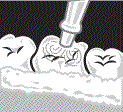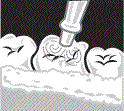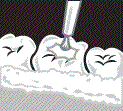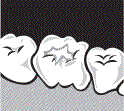
What are dental sealants?
Sealants are thin, plastic coatings painted on the chewing surfaces of the back teeth.
Sealants are put on in dentists' offices, clinics, and sometimes in schools. Getting sealants put on is simple and painless. Sealants are painted on as a liquid and quickly harden to form a shield over the tooth.
 Back to Top
Back to Top
How are sealants put on?
 1. The tooth is cleaned.
1. The tooth is cleaned. 2. The tooth is dried, and cotton is put around the tooth so it stays dry.
2. The tooth is dried, and cotton is put around the tooth so it stays dry. 3. A solution is put on the tooth that makes the surface a little rough. (It is easier for the sealant to stick to a slightly rough surface.)
3. A solution is put on the tooth that makes the surface a little rough. (It is easier for the sealant to stick to a slightly rough surface.)
 4. The tooth is rinsed and dried. Then new cotton is put around the tooth so it stays dry.
4. The tooth is rinsed and dried. Then new cotton is put around the tooth so it stays dry. 5. The sealant is applied in liquid form and hardens in a few seconds.
5. The sealant is applied in liquid form and hardens in a few seconds. 6. The sealant is in place.
6. The sealant is in place.
 Back to Top
Back to Top
Why get sealants?
The most important reason for getting sealants is to avoid tooth decay.
Fluoride in toothpaste and in drinking water protects the smooth surfaces of teeth but back teeth need extra protection. Sealants cover the chewing surfaces of the back teeth and keep out germs and food.
Having sealants put on teeth before they decay will also save time and money in the long run by avoiding fillings, crowns, or caps used to fix decayed teeth.
 Back to Top
Back to Top
What causes tooth decay?
Germs in the mouth use the sugar in food to make acids. Over time, the acids can make a cavity in the tooth.
Of course a healthy tooth is the best tooth. So it is important to prevent decay. That's why sealants are so important.
 Back to Top
Back to Top
Why do back teeth decay so easily?
The chewing surfaces of back teeth are rough and uneven because they have small pits and grooves. Food and germs can get stuck in the pits and grooves and stay there a long time because toothbrush bristles cannot brush them away.
 Back to Top
Back to Top
Who should get sealants?
Children should get sealants on their permanent molars as soon as the teeth come in -- before decay attacks the teeth.
The first permanent molars -- called "6 year molars" -- come in between the ages of 5 and 7.
The second permanent molars -- "12 year molars" -- come in when a child is between 11 and 14 years old.
Other teeth with pits and grooves also might need to be sealed.
Teenagers and young adults who are prone to decay may also need sealants.
 Back to Top
Back to Top
Should sealants be put on baby teeth?
Your dentist might think it is a good idea, especially if your child's baby teeth have deep pits and grooves.
Baby teeth save space for permanent teeth. It is important to keep baby teeth healthy so they don't fall out early.
 Back to Top
Back to Top
Does insurance pay for sealants?
Some health insurance programs pay for sealants. Check with your state Medicaid program or your insurance company for details.
 Back to Top
Back to Top
How long do sealants last?
Sealants can last up to 10 years. But they need to be checked at regular dental check-ups to make sure they are not chipped or worn away. The dentist or dental hygienist can repair sealants by adding more sealant material.
 Back to Top
Back to Top
What if a small cavity is accidentally covered by a sealant?
The decay will not spread, because it is sealed off from its food and germ supply.
 Back to Top
Back to Top
Are sealants new?
No, sealants have been around since the 1960s. Studies by the National Institute of Dental and Craniofacial Research and others led to the development of dental sealants and showed that they are safe and effective.
But many people still do not know about sealants. In fact, fewer than one-third of children in the United States have sealants on their teeth.
 Back to Top
Back to Top
Besides sealants, are there other ways to prevent tooth decay?
Yes. Using fluoride toothpaste and drinking fluoridated water can help protect teeth from decay.
Water is fluoridated in about two-thirds of cities and towns in the United States. If your water is not fluoridated or if your children's teeth need more fluoride to stay healthy, a dentist can prescribe it in the form of a gel, mouthrinse, or tablet.
Fluoride is the best defense against tooth decay!
Fluoride...
- makes teeth more resistant to decay
- repairs tiny areas of decay before they become big cavities
- makes germs in the mouth less able to cause decay
Fluoride helps the smooth surfaces of the teeth the most. It is less effective on the chewing surfaces of the back teeth. Regular brushing -- with fluoride toothpaste -- also helps prevent tooth decay.
Sealants and fluoride together can prevent almost all tooth decay.
 Back to Top
Back to Top
How can I get dental sealants for my children?
Talk to your dentist, state or local dental society, or health department. Sometimes sealants are put on at school. Check with your school about whether it has a sealant program.
 Back to Top
Back to Top
This information is not copyrighted. Print and make as many photocopies as you need.
NIH Publication No. 09-489